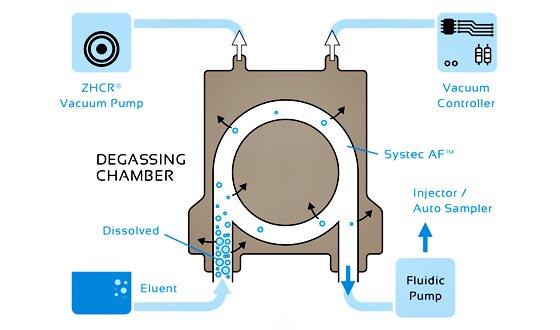What if there was a way to enrich liquids with gases of interest, in a controlled manner?
Biotech Fluidics offers high-efficiency in line degassing equipment to obtain >90% removal of dissolved gasses from liquids, employing vacuum-based degassing. Some applications, however, require the opposite, i.e. enrichment of certain gasses in given liquids. Utilizing the reversed principle of vacuum-based degassing, we here present new insight on the vacuum-chamber, which can evidently be used to enrich fluids with gases of interest. By applying an over-pressure of a given gas on the chamber, through which your fluid of interest is pumped, the amount of dissolved gas can be substantially increased, allowing you to regulate the gas content in a highly controlled manner.
The principle was demonstrated by pumping tap water through a 9000-1523 degassing chamber with and without over-pressure of air (0.15 MPa). As expected, the enrichment of oxygen is highly temperature dependent, while the flowrate displays a negligible impact. With the current setup, the amount of dissolved oxygen could easily be increased by 100%, corresponding to an absolute enrichment of approximately 6.7 mg/ml at 10 °C and 7 ml/min. Due to lower solubility of gasses at high temperatures, the enrichment was 2.6 mg/ml at 50 °C and 7 ml/min, yet corresponding to 67% increase.
This shows the dual functionality of the vacuum chamber, which appears to be not only great for degassing purposes, but is also a terrific device for dissolved gas enrichment. Using such a chamber you can now easily add an in-line mechanism to your setup to boost the solutions with gasses of interest.
Learn more about the Biotech Fluidics vacuum chambers at the product webpages linked below, or contact Biotech Fluidics to discuss the most appropriate chamber for your application.

Experimental details: 0.15 MPa overpressure of air was applied on a 9000-1523 degassing chamber, through which regular tap water at various temperatures was pumped at 7 ml/min and 14 ml/min respectively. The amount of dissolved oxygen was monitored continuously before and after the pressurized chamber.

